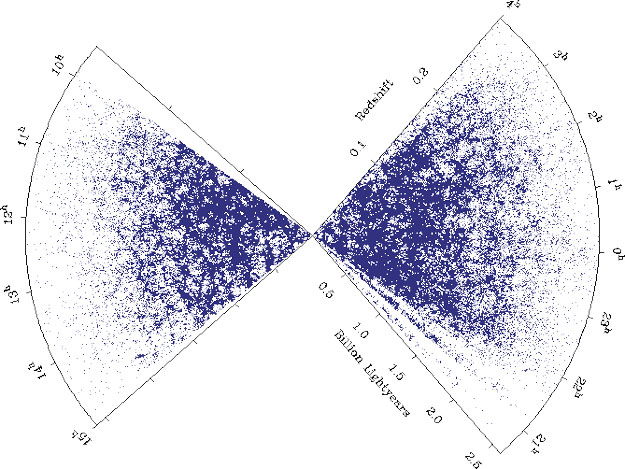
|
Explanation: How are galaxies distributed in the universe? This question is of more than aesthetic interest because the answer likely holds clues to composition of the universe itself. The above map shows the distribution of nearly 200,000 galaxies and is the latest answer obtained by one of the most complex astronomical instruments yet created: the Two-Degree Field (2dF) system. The 2dF system measures galaxy redshifts, allowing astronomers to estimate distances to some of the millions of galaxies visible, and hence to make a three-dimensional map of the local universe. Although the distribution of galaxies appears nearly uniform on the largest scale, waves of galaxies are discernable extending up to 100 million light-years. Detailed analyses of the incoming data indicate that to create such a network of waves, normal baryonic matter must make up only 15 percent of all matter, while all matter must make up only about 30 percent of that needed to make the universe geometrically flat. Is the remaining 70 percent dark energy?
|
January February March April May June July August September October November December |
| ||||||||||||||||||||||||||||||||||||||||||||||||
NASA Web Site Statements, Warnings, and Disclaimers
NASA Official: Jay Norris. Specific rights apply.
A service of: LHEA at NASA / GSFC
& Michigan Tech. U.
Based on Astronomy Picture
Of the Day
Publications with keywords: galaxies - redshift survey
Publications with words: galaxies - redshift survey
See also:
- APOD: 2025 August 28 Á Galaxies, Stars, and Dust
- APOD: 2025 March 2 Á The Hubble Ultra Deep Field in Light and Sound
- APOD: 2024 December 31 Á The Twisted Disk of NGC 4753
- APOD: 2024 December 18 Á NGC 660: Polar Ring Galaxy
- Stellar Streams in the Local Universe
- APOD: 2024 April 15 Á The Cigar Galaxy from Hubble and Webb
- APOD: 2024 March 20 Á The Eyes in Markarians Galaxy Chain
